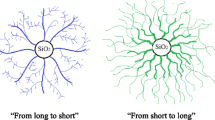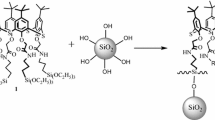Abstract
Core–shell structured nanocomposites of polydimethylsiloxane with different polymerization degree (PMS100 and PMS50) and polymethylphenylsiloxane (PMPS4) immobilized onto fumed silica nanoparticles were studied by means of differential scanning calorimetry. The polysiloxanes were attached to the particles’ surface using thermally stimulated binding and modification in the presence of depolymerization activator—dimethyl carbonate (DMC). Single- and multi-stage processes were applied in order to obtain a different architecture of polymeric layer on the silica nanoparticles surface. The effect of polysiloxane/DMC ratio on phase transitions of obtained polymeric layers was evaluated. The grafting of polydimethylsiloxane at the presence of chain scissor resulted in cross-linking of the attached polymeric layers. When using a multi-step modification with PMPS, a dense cross-linked layer was formed on the silica surface. Unlike the samples obtained by one-step modification with different polymer content, for which the amount of polymer attached to silica surface changes the parameters of the relaxation process in polymeric layer, for composites synthesized using multi-stage modification, a greater influence has the length of the oligomer introduced on first stage. The best results were achieved for composite with PMPS when using on the first stage of modification the PMPS/DMC mixture with low content of depolymerization agent (oligomers with long chain, respectively). A notable increase in the mobility of the polymeric layer was detected due to the formation of isotactic macromolecular chains.





Similar content being viewed by others
References
Takei T, Nakada M, Yoshikawa N, Hiroe Y, Yoshida H. Effect of organic functional groups on the phase transition of organic liquids in silica mesopores. J Term Anal Calorim. 2016;123(3):1787–94.
Goncharuk OV. The heat of immersion of modified silica in polar and nonpolar liquids. J Term Anal Calorim. 2015;120(2):1365–73.
Litvinov VM, Barthel H, Weis J. Structure of a PDMS layer grafted onto a silica surface studied by means of DSC and solid-state NMR. Macromolecules. 2002;35:4356–64.
Graubner VM, Jordan R, Nuyken O. Photochemical modification of cross-linked poly(dimethylsiloxane) by irradiation at 172 nm. Macromolecules. 2004;37(16):5936–43.
Vu BTN, Mark JE, Schaefer DW. Interfacial modification for controlling silica–polysiloxane interactions and bonding in some elastomeric composites. Compos Interfaces. 2003;10:451–73.
Zhan X, Zhang J, Cheng J, Shi L, Lin X. Synthesis, characterization, and cure kinetics analysis of high refractive index copolysiloxanes. J Term Anal Calorim. 2014;117(2):875–83.
Radi S, Basbas N, Tighadouini S, Bacquet M. New polysiloxane surfaces modified with ortho-, meta- or para-nitrophenyl receptors for copper adsorption. J Surf Eng Mater Adv Technol. 2014;4:21–8.
Fadeev AY, Kazakevich YV. Covalently attached monolayers of oligo(dimethylsiloxane)s on silica: a siloxane chemistry approach for surface modification. Langmuir. 2002;18:2665–72.
Rózga-Wijas K, Chojnowski J, Fortuniak W, Scibiorek M, Michalska Z, Rogalski Ł. Branched functionalised polysiloxane–silica hybrids for immobilisation of catalysts. J Mater Chem. 2003;13:2301–10.
Guo J, Saha P, Liang J, Saha M, Grady BP. Multi-walled carbon nanotubes coated by multi-layer silica for improving thermal conductivity of polymer composites. J Term Anal Calorim. 2013;113(2):467–74.
Borysenko MV, Bogatyrov VM, Dyachenko AG. Effect of chemical modification of silica surface with metal oxides on the thermal properties of adsorbed polydimethylsiloxane. Chem Phys Technol Surf Interdep Dig. 2002;7–8:11–8.
Sulym IY, Borysenko MV, Goncharuk OV, Terpilowski K, Sternik D, Chibowski E, Gun’ko VM. Structural and hydrophobic–hydrophilic properties of nanosilica/zirconia alone and with adsorbed PDMS. Appl Surf Sci. 2011;258:270–7.
O’Shaughnessy B. Non-equilibrium in adsorbed polymer layers. J Phys: Condens Matter. 2005;17:63–99.
Tsubokawa N. Surface grafting of polymers onto nanoparticles in a solvent-free dry-system and applications of polymer-grafted nanoparticles as novel functional hybrid materials. Polym J. 2007;39:983–1000.
Tundo P. New developments in dimethyl carbonate chemistry. Pure Appl Chem. 2001;73(7):1117–24.
Klonos P, Sulym IY, Kyriakos K, Vangelidis I, Zidropoulos S, Sternik D, Borysenko MV, Kyritsis A, Deryło-Marczewska A, Gun’ko VM, Pissis P. Interfacial phenomena in core–shell nanocomposites of PDMS adsorbed onto low specific surface area fumed silica nanooxides: effects of surface modification. Polymer. 2015;68:158–67.
Klonos P, Sulym IY, Borysenko MV, Gun’ko VM, Kripotou S, Kyritsis A, Pissis P. Interfacial interactions and complex segmental dynamics in systems based on silica-polydimethylsiloxane core–shell nanoparticles: dielectric and thermal study. Polymer. 2015;58:9–21.
Klonos P, Kyritsis A, Pissis P. Interfacial dynamics of polydimethylsiloxane adsorbed on fumed metal oxide particles of a wide range of specific surface area. Polymer. 2015;77:10–3.
Klonos P, Kyritsis A, Pissis P. Effects of surface modification and thermal annealing on the interfacial dynamics in core–shell nanocomposites based on silica and adsorbed PDMS. Eur Polym J. 2015;70:342–59.
Okamoto M, Suzuki S, Suzuki E. Polysiloxane depolymerization with dimethyl carbonate using alkali metal halide catalysts. Appl Catal. 2004;261:239–45.
Protsak IS, Kuzema PO, Tertykh VA, Bolbukh YM, Kozakevych RB. Thermogravimetric analysis of silicas chemically modified with products of deoligomerization of polydimethylsiloxane. J Term Anal Calorim. 2015;121(2):547–57.
Jones RG, Ando W, Chojnowski J. Silicon-containing polymers. The science and technology of their synthesis and applications. The Netherlands: Kluwer Academic Publishers; 2000 768 p.
Bolbukh Y, Tertykh V, Klonos P, Pissis P. DSC-study of polyhydroxyethylmethacrylate filled with modified silicas. J Therm Anal Calorim. 2011;108:1111.
Mironuk IF, Kurta SA, Gergel TV, Voronin EP, Cheladin VL, Kyrta OC. The chemosorbtion of oligomeric polymethylsiloxane on the surface of fumed silica. Phys Chem Solid State (in Ukr). 2009;10:157–65.
Fragiadakis D, Pissis P. Glass transition and segmental dynamics in poly(dimethylsiloxane)/silica nanocomposites studied by various techniques. J Non-Cryst Solids. 2007;353:4344–52.
Sulym I, Klonos P, Borysenko M, Pissis P, Gun’ko VM. Dielectric and thermal studies of segmental dynamics in silica/PDMS and silica/titania/PDMS nanocomposites. J Appl Polym Sci. 2014;. doi:10.1002/APP.41154.
Acknowledgements
The research leading to these results has received funding from the People Programme (Marie Curie Actions) of the European Union’s Seventh Framework Programme FP7/2007-2013/under REA Grant Agreements No. PIRSES-GA-2013-612484.
Author information
Authors and Affiliations
Corresponding author
Rights and permissions
About this article
Cite this article
Bolbukh, Y., Koutsoumpis, S., Georgopoulos, D. et al. DSC study of silicas with immobilized polysiloxane layer of different architecture. J Therm Anal Calorim 125, 1399–1409 (2016). https://doi.org/10.1007/s10973-016-5618-0
Received:
Accepted:
Published:
Issue Date:
DOI: https://doi.org/10.1007/s10973-016-5618-0




